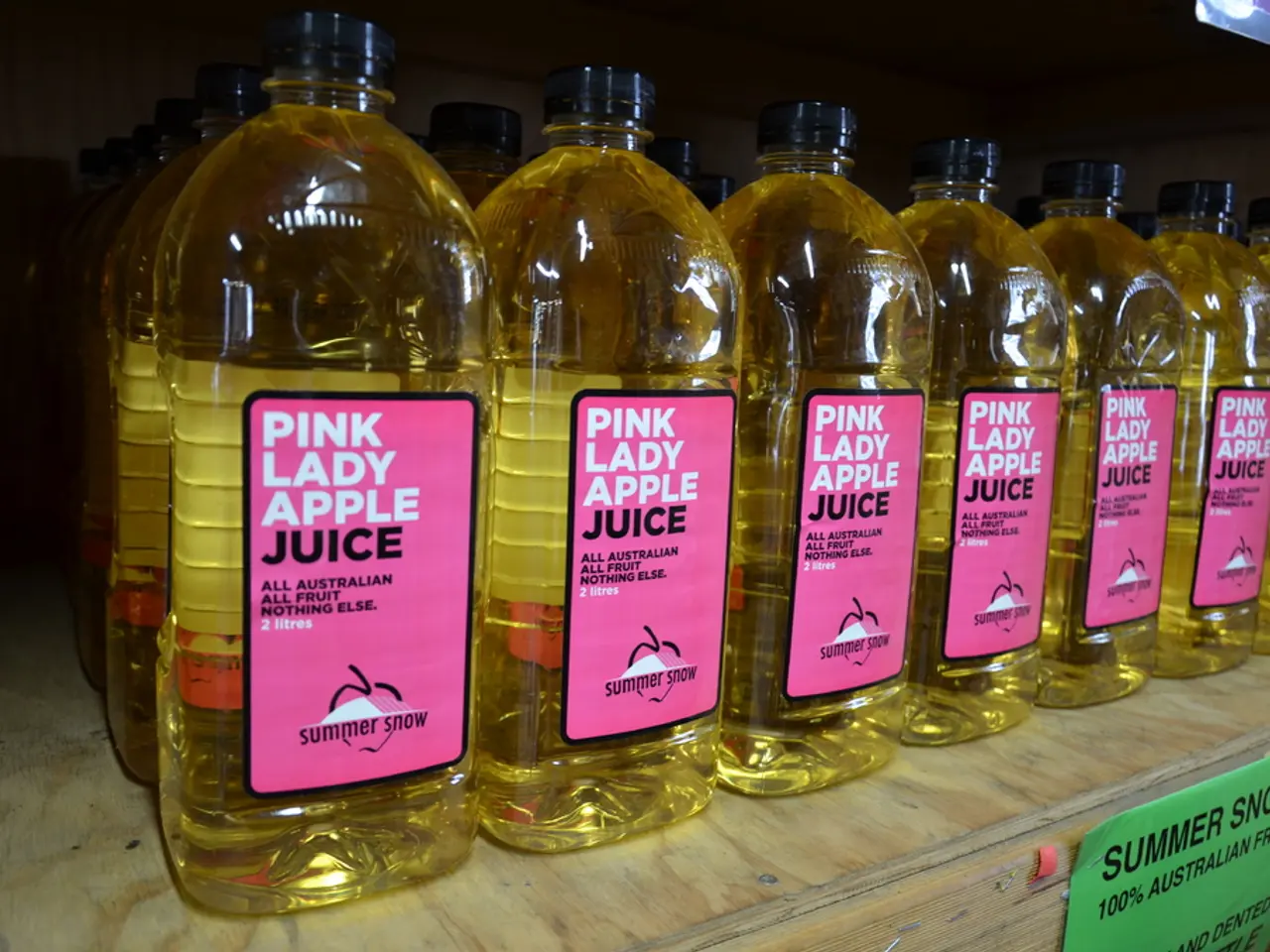Grape juice and stomach flu: Insights from scientific research
In the United States, approximately 27 million people contract stomach flu, also known as viral gastroenteritis, each year. This highly contagious illness can be caught from an infected person, contaminated surfaces, or consuming food or drinks prepared by a person with the illness [1].
The Centers for Disease Control and Prevention (CDC) advises that a person with norovirus or stomach flu symptoms should not prepare food for others and recommends washing any items the person uses at the hottest temperature the fabric allows, washing them immediately if they come into contact with any vomit or feces [2].
The CDC also stresses the importance of maintaining a clean environment. They recommend keeping surfaces clean and disinfected as part of regular household cleaning, and a thorough cleanup immediately if someone with stomach flu vomits or has diarrhea [3].
While some people believe that drinking grape juice may help prevent stomach flu, there is no scientific evidence to support this belief. Grapes and grape juices are high in vitamin C, which boosts the immune system and helps fight off illness, but this does not translate to a direct antiviral effect on stomach viruses [4].
A study published in the journal Nutrients suggests that taking a grape powder supplement can increase gut microbiome diversity, which may promote good health. However, this does not imply that grape juice has antiviral properties against stomach viruses [5].
Current scientific research does not specifically support the belief that drinking grape juice prevents or treats stomach viruses. While some juices, like grapefruit juice, have been studied for their effects on the intestines, direct antiviral effects of grape juice on stomach viruses are not established in research [6].
The CDC acknowledges that there are no specific medicines to treat stomach flu and recommends drinking lots of liquids to replace those lost through vomiting or diarrhea [7].
In terms of nutritional advice, when dealing with digestive conditions, grape juice may be included due to its gentle nature and nutrition, but this is dietary management rather than evidence of antiviral treatment [8].
The CDC also emphasises the importance of good hygiene practices. They recommend a proper hand hygiene regime, including washing hands regularly with soap and water, being extra careful after using the toilet or changing a diaper, before preparing food or eating, and before taking any medication [9].
People with stomach flu are recommended to drink plenty of liquids to prevent dehydration [10]. However, when it comes to preventing or treating stomach flu, the focus should be on maintaining good hygiene practices and a healthy lifestyle, rather than relying on specific foods or drinks.
References:
- Centers for Disease Control and Prevention. (2021). Norovirus - CDC Fact Sheet. Retrieved from https://www.cdc.gov/norovirus/about/fs-norovirus.html
- Centers for Disease Control and Prevention. (2021). Cleaning and Disinfection for Norovirus. Retrieved from https://www.cdc.gov/norovirus/prevention-and-control/cleaning-disinfection.html
- Centers for Disease Control and Prevention. (2021). Norovirus - Preventing Spread in Child Care Settings. Retrieved from https://www.cdc.gov/norovirus/prevention-and-control/child-care-settings.html
- Centers for Disease Control and Prevention. (2021). Fruit Juice and Your Child's Diet. Retrieved from https://www.cdc.gov/nutrition/infantandtoddlernutrition/fruitjuice.html
- Bauer, J. A., & Cox, M. M. (2018). Grape juice and gut health: A review. Nutrients, 10(10), 1534.
- Food Control, (2015). Resveratrol as a potential inhibitor of feline calicivirus infection: implications for norovirus. Food Control, 53, 186-193.
- Centers for Disease Control and Prevention. (2021). Norovirus - Treatment. Retrieved from https://www.cdc.gov/norovirus/about/treatment.html
- Mayo Clinic. (2021). Grape Juice: Health Benefits, Nutrition, and Risks. Retrieved from https://www.mayoclinic.org/foods/grape-juice/nutrition-charts/grape-juice
- Centers for Disease Control and Prevention. (2021). Handwashing. Retrieved from https://www.cdc.gov/handwashing/index.html
- Centers for Disease Control and Prevention. (2021). Norovirus - Symptoms and Complications. Retrieved from https://www.cdc.gov/norovirus/about/symptoms-and-complications.html
- The long-term effects of depression can lead to various chronic diseases, such as cardiovascular health issues and diabetes.
- Alzheimer's disease is a form of degenerative brain disorder that primarily affects the elderly, causing memory loss and cognitive decline.
- Macular degeneration is a condition that primarily affects the elderly, causing damage to the macula, which is a part of the eye responsible for central vision.
- Obesity has been linked to an increased risk of various respiratory conditions, including asthma and sleep apnea.
- Dry skin can be a symptom of various health issues, such as diabetes or thyroid problems, and may require specific therapies and treatments.
- Bipolar disorder is a mental health condition characterized by episodes of extreme mood swings that include emotional highs (mania or hypomania) and lows (depression).
- The flu season can impact workforce productivity and workplace wellness, particularly in industries such as manufacturing and retail.
- Proper medical-conditions management is crucial in the workplace to ensure employee health and wellness, including fitness and exercise, skin care, and mental health counseling services.
- Chronic diseases, such as cancer, diabetes, and heart disease, can affect an individual's ability to work and require long-term care and management.
- Science continues to explore predictive analyses and data for various medical conditions, including the early detection of macular degeneration and Alzheimer's disease.
- The AQ (Air Quality) index is a crucial element in environmental-science, playing a significant role in various industries, such as manufacturing and transportation.
- Science also plays a critical role in finance, particularly in sectors such as energy and investing, where predictive analytics can be used to forecast market trends and risks.
- Space and astronomy are fields that rely heavily on technology and artificial intelligence, pushing the boundaries of our understanding of the universe.
- In the realm of lifestyle, nutrition plays a vital role in weight management, cardiovascular health, and overall well-being.
- Dietary practices focusing on nutrient-dense foods, such as fruits, vegetables, and whole grains, can contribute to weight management and help reduce the risk of various chronic diseases.
- Climate change can impact various aspects of our lives, such as food security, water availability, and the prevalence of infectious diseases like the flu.
- In the realm of healthcare, the industry continues to evolve with advancements in technology and treatments, such as the increasing use of wearables and smart-home devices for chronic-disease management.
- Financial institutions are starting to incorporate workplace-wellness programs into their business strategies, offering services such as mental-health counseling and fitness classes.
- The real-estate market can be influenced by various factors, including environmental concerns, economic trends, and demographic shifts.
- In the face of climate change, tech companies are developing innovative solutions, such as energy-efficient buildings and renewable energy sources.
- Entrepreneurship plays a crucial role in diversifying industries, offering unique solutions and products that cater to changing consumer needs.
- Transportation advancements, such as smart transportation systems and electric vehicles, can contribute to reductions in greenhouse gas emissions and help combat climate change.
- Leadership in any industry requires a diverse workforce that promotes inclusion, fostering creativity, innovation, and productivity.
- Diversity and inclusion efforts can also extend to technology, ensuring accessibility and representation for all users, such as people with disabilities or different cultural backgrounds.
- Smartphones and other gadgets have become essential tools for modern-day business and personal communication, influencing various industries, including banking, retail, and venture-capital investing.
- Data and cloud computing have transformed numerous industries, from financial services to healthcare, enabling more efficient operations, better decision-making, and innovative solutions.
- The internet of things (IoT) has expanded beyond smart homes to include smart cities and smart agriculture, promising improvements in energy efficiency, resource management, and overall sustainability.
- Gardening has gained popularity as a hobby and a form of stress relief, with benefits to both physical and mental health.
- Proper budgeting and debt management are crucial components of personal-finance literacy, enabling individuals to make informed financial decisions and build wealth.
- The fintech industry continues to evolve, with innovations such as digital banking, mobile payments, and financial education tools.
- Banking and insurance are two integral parts of financial services, providing essential services such as savings, loans, and risk management.
- The stock market and private-equity investments are popular methods for individuals and institutions to grow their wealth, though they come with inherent risks and require careful consideration.
- Despite the inherent risks and instability, saving and debt management remain key to building long-term financial security and wealth.








